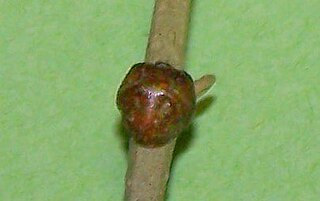
Cutworms are moth larvae that hide under litter or soil during the day, coming out in the dark to feed on plants. A larva typically attacks the first part of the plant it encounters, namely the stem, often of a seedling, and consequently cuts it down; hence the name cutworm. Cutworms are not worms, biologically speaking, but caterpillars.

Mocis frugalis, the sugarcane looper, is a moth of the family Erebidae. The species was first described by Johan Christian Fabricius in 1775. It is found in several parts of the world, including India, Sri Lanka, West African countries and other Oriental regions. The adult is a fruit piercer and a major pest of crops.

The fall armyworm is a species in the order Lepidoptera and is the larval life stage of a fall armyworm moth. The term "armyworm" can refer to several species, often describing the large-scale invasive behavior of the species' larval stage. It is regarded as a pest and can damage and destroy a wide variety of crops, which causes large economic damage. Its scientific name derives from frugiperda, which is Latin for lost fruit, named because of the species' ability to destroy crops. Because of its propensity for destruction, the fall armyworm's habits and possibilities for crop protection have been studied in depth. It is also a notable case for studying sympatric speciation, as it appears to be diverging into two species currently. Another remarkable trait of the larva is that they practice cannibalism as a disease control mechanism.

Delgamma is a monotypic moth genus of the family Noctuidae erected by Frederic Moore in 1885. Its only species, Delgamma pangonia, the strawberry cutworm, was first described by Achille Guenée in 1852.

Eublemma is a genus of moths of the family Erebidae described by Jacob Hübner in 1829.

Brithys crini, the amaryllis borer, crinum borer, lily borer or Kew arches, is a moth of the family Noctuidae. It is a garden pest in parts of its range, as their larvae damage the stems and leaves of lilies, especially lilies of the family Amaryllidaceae.

Spodoptera mauritia, the lawn armyworm or paddy swarming caterpillar, is a moth of the family Noctuidae. The species was first described by Jean Baptiste Boisduval in 1833. Able to eat many types of food, it is a major pest throughout the world.

Dudua aprobola, the mango flower webworm or litchi leaf roller, is a moth of the family Tortricidae. The species was first described by Edward Meyrick in 1886. It is a pest on several economically important crops.
Saissetia coffeae, known generally as hemispherical scale, is a species of soft scale insect in the family Coccidae. Other common names include the helmet scale and coffee brown scale.
Saissetia is a genus of soft scale insects in the family Coccidae. There are at least four described species in Saissetia.

Anomis fulvida is a moth of the family Erebidae first described by Achille Guenée in 1852. It is found in Australia, African countries like Sierra Leone, South Africa, Tanzania, and Asian countries like Sri Lanka.
Naranga diffusa, the rice green semilooper, is a moth of the family Noctuidae. The species was first described by Francis Walker in 1865. It is found in many agricultural based countries such as Bangladesh, India, Sri Lanka, China, Hong Kong, Iran, Japan, the Korean Peninsula, Malaysia, Myanmar, the Philippines, Thailand, Taiwan and Vietnam.

Polytela gloriosae, the Indian lily moth or lily caterpillar, is a moth of the family Noctuidae. The species was first described by Johan Christian Fabricius in 1781. It is found in Sri Lanka, India and probably in Indonesia.

Chlumetia transversa, the mango shoot borer, is a moth of the family Euteliidae. The species was first described by Francis Walker in 1863. It is a widely distributed across Indo-Australian tropical countries far east to Solomon Islands.
Eublemma amabilis is a moth of the family Noctuidae first described by Saalmüller in 1891. It is found in India, Bangladesh and Sri Lanka.

Dichromia orosia, sometimes as Dichromia sagitta, is a moth of the family Erebidae first described by Edward Meyrick in 1913. It is found in Sri Lanka and Australia. The caterpillar is a pest of Marsdenia species, Tylophora asthntatica and Tylophora indica.

Saissetia oleae is a scale insect in the family Coccidae. It is considered one of the three main phytophagous parasites of the olive tree, together with the olive fruit fly and the olive moth. Although it is a common parasite which occurs most often in olive trees, it is a polyphagous species, also attacking citrus trees as well as various ornamental shrubs such as oleanders, pittosporums and euonymus.
Selepa celtis, called the hairy caterpillar as a larva, is a moth of the family Nolidae. The species was first described by Moore in 1858. It is found in Oriental tropics of India, Sri Lanka, Taiwan towards the Ryukyu Islands and Australia.

Earias cupreoviridis, called the cupreous bollworm as a larva, is a moth of the family Nolidae. The species was first described by Francis Walker in 1862. It is found in African countries like Botswana, the Democratic Republic of the Congo, Eritrea, Ethiopia, the Gambia, Kenya, Nigeria, Sierra Leone, South Africa, Togo, Uganda, Zimbabwe to Asian countries like India, Sri Lanka, China, Japan, Korea, Philippines, Indonesia and Hong Kong.
Metaphycus helvolus is a species of parasitic wasp in the family Encyrtidae native to South Africa. It is a parasitoid of soft scale insects and has been used in their biological control in California and Australia.














